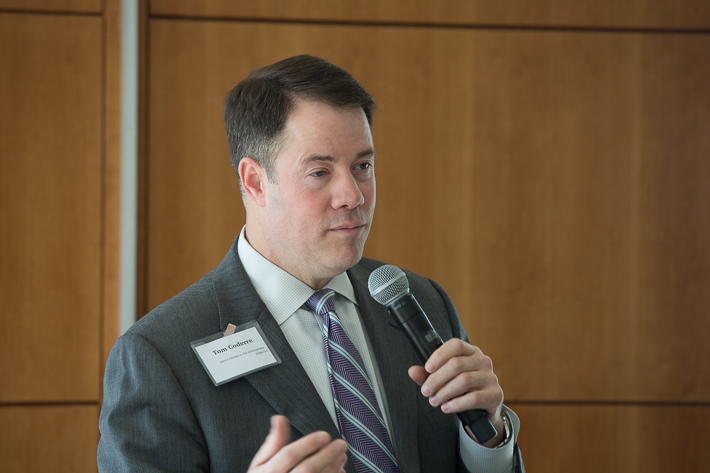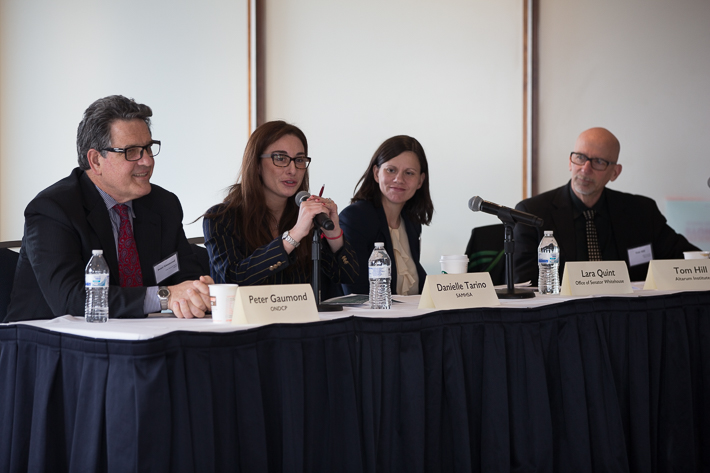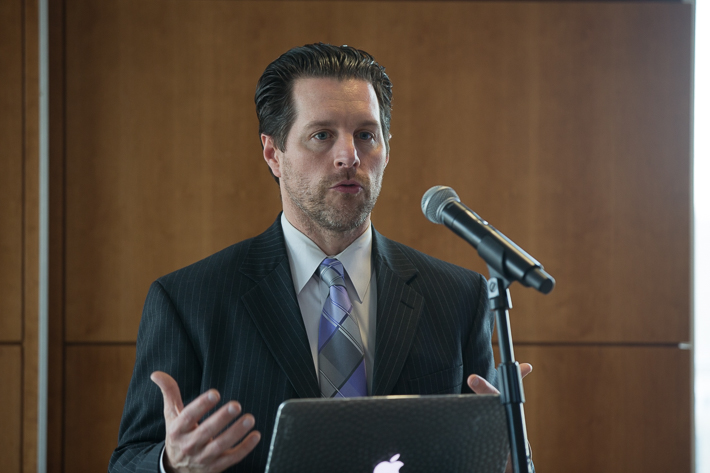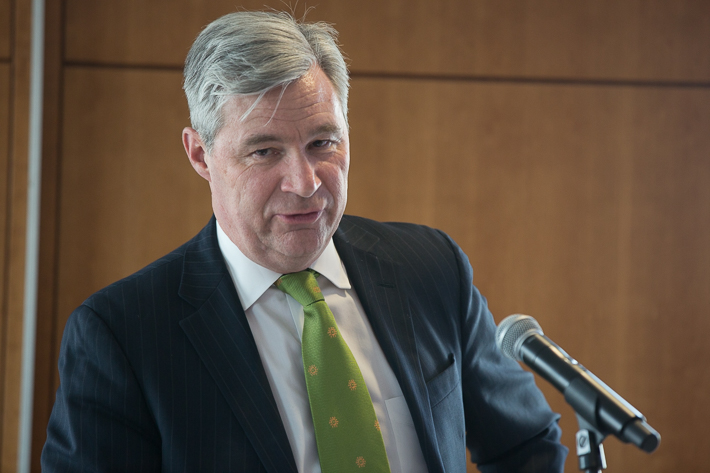While a student at Wayne State University, Ivana Grahovac—now the executive director of Transforming Youth Recovery— expected a typical college experience.
She took classes. She studied in the library. She even secured an internship in the office of former President Bill Clinton.
But then Ms. Grahovac began battling an addiction to heroin, an eating disorder and alcoholism. Her road to recovery took more than a decade.
“The only reason I graduated after eight years was because my mom drove me to school every single day and sat next to me in class for an entire semester,” Ms. Grahavoc said Thursday.
Her road to recovery included a period of homelessness on the streets of Detroit, jail time and six stints in rehab. In 2009, Ms. Grahavoc entered a graduate program at the University of Michigan, where she was determined to create a community of support for students and by students—that community launched the university’s collegiate recovery program.
“Collegiate recovery—and the people in that community—saved my life,” Ms. Grahavoc said.
The George Washington University Students for Recovery (SFR) hosted Ms. Grahavoc and a cadre of experts, legislators, advocates and allies Thursday for the inaugural Raise High for Recovery Day.

GW Students for Recovery members, sophomore Jenny Curt and senior and SFR President Tim Rabolt outside the city view room Thursday.
They gathered to strategize new ways to build campus-based and legislative support nationwide for students in recovery who are juggling academics, self-care and social lives.
There are currently more than 100 collegiate recovery programs in the United States, according to the Association of Recovery in Higher Education. These organizations provide a community of care to students managing addiction and substance abuse and mental health disorders.
“Today is really about celebrating students in recovery—not just at GW but across the nation,” said senior and SFR President Tim Rabolt. “It’s about raising awareness for students who are battling addiction and other forms of mental illness and increasing support for them.”

Tom Coderre, senior advisor to Substance Abuse and Mental Health Services Administration, said that being in recovery is the thing he considers most important about himself.
Founded in 2012 and advised by Health Promotion and Prevention Services and the Center for Student Engagement, SFR focuses on peer-to-peer support and social activities that encourage sobriety.
The organization previously hosts a weekly group counseling session at the Colonial Health Center with Mental Health Services Assistant Director of Clinical Services Kate Seldon and promotes engagement with mental health resources on and off campus.
SFR was featured in a recent educational webcast for the Substance Abuse and Mental Health Services Administration (SAMSHA), and the organization will be among the presenters at the ARHE national conference in May.
Raise High for Recovery day morning panelists focused on policy intiatives that support long-term recovery for students.
Mr. Rabolt said that much of what SFR has been able to accomplish comes from the support of the university. SFR presented GW Dean of Student Affairs Peter Konwerski with the campus award at the Recovery Day reception—one of four awards given to national, collegiate, innovative and campus supporters.
Dr. Konwerski announced a new graduate fellowship in the Division of Student Affairs for the 2015-16 academic year that is funded by an anonymous donor. The selected student will connect campus-wide recovery efforts and help develop a plan to build and expand GW’s collegiate recovery program.
“It’s been an honor to work with the students throughout the year and to accept the campus award on behalf of the university administration, which fully supports the efforts of GW Students for Recovery,” Dr. Konwerski said
SAMSHA Senior Advisor Tom Coderre, Office of National Drug Control Policy Recovery Branch Chief Peter Gaumond and five collegiate recovery program directors were among the day’s panelists.
Robert Ashford, director of the collegiate recovery program at the University of North Texas, was among the panelists who shared how they felt isolated during their journeys to sobriety because college was a “recovery hostile” environment.
 Four collegiate recovery program coodinators and managers—Jason Whitney, Sarah Nerad, Devin Reaves and Robert Ashford —sat on the afternoon panel. (L-R)
Four collegiate recovery program coodinators and managers—Jason Whitney, Sarah Nerad, Devin Reaves and Robert Ashford —sat on the afternoon panel. (L-R)
Mr. Ashford said that when he returned to school in his mid -twenties after entering recovery, he was lost. He spent 70 to 90 percent of his time on campus, but he had to leave to find recovery meetings and other support.
“I didn’t have the support network to create a healthy lifestyle,” Mr. Ashford said. “What the school told me was ‘we know you’re a part of this marginalized group but we never thought to create services for you.’ It was a slap in the face.”
The panelists agreed that the collegiate recovery movement should focus on shifting the conversation around substance misuse disorders from negative to positive. For example, using the designation “person in recovery” rather than “former drug abuser or addict.”
Eliminating the stigma associated with recovery would garner support from universities as well as legislators, panelists said.
“It’s a really brave thing to walk the path of recovery,” U.S. Sen. Sheldon Whitehouse (D-RI) said at the reception. “It deserves honor, respect not stigma and shame. I am really proud of this university and this organization for taking these steps… You will be a light to others.”

GW Dean of Student Affairs introduced Sen. Whitehouse and later received the campus award from SFR for the university's efforts to suport the student organization.
Sen. Whitehouse—who is also a GW parent— is the co-author of the bipartisan Comprehensive Addiction Recovery Act, which would launch a National Youth Recovery Initiative that would authorize the ONDCP and the Department of Education to give grants to high schools, universities and nonprofit organizations
Passing improved legislation will depend on the voices and support from young people, according to Danielle Tarino, public health advisor of SAMSHA.
“It’s important to acknowledge that we are rolling and more is coming down the pike,” Ms. Tarino said. “There are about 30,000 draconian laws on the books stopping students—stopping us from getting better. We have to make our voices heard.”
To that end, members of GW SFR encourage the university community to get involved by connecting on social media and participating in events on campus. According to sophomore Jenny Curt, the magic of SFR will always be its ability to connect students to a community of support.
“The most rewarding part of the Recovery Day experience was the networking, communication and unity that occurred to celebrate the recovery movement,” Ms. Curt said. “While it's crucial to recognize our organized supporters, celebrating the accomplishments, leadership and camaraderie among individual students will always be the most important element of SFR.”


